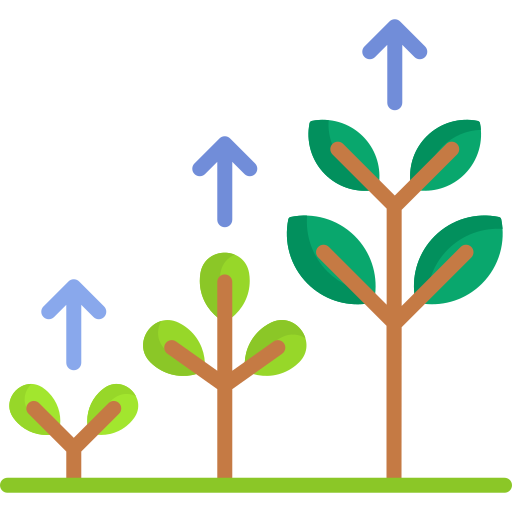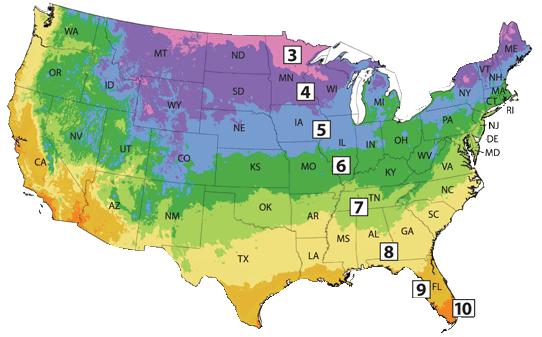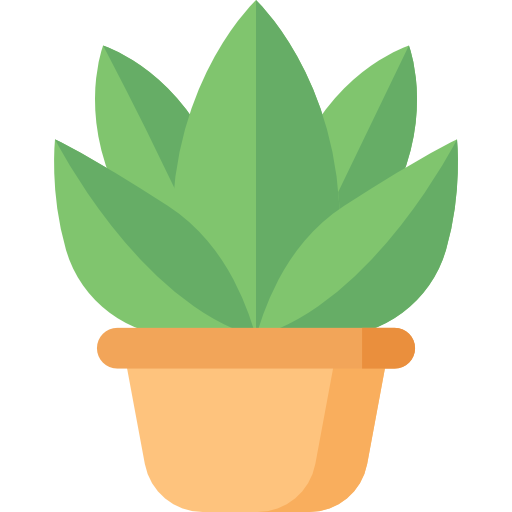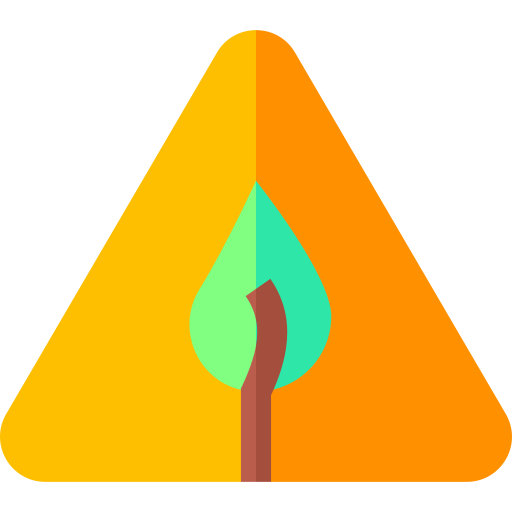Everything You Need to Know About Yucca Plants – Yuccas Care Guide
Updated: July 09, 2025

Y ucca plants, with their striking appearance and resilience, have captured the hearts of succulent enthusiasts and desert lovers alike. These unique, low-maintenance Yucca plants belong to the genus Yucca and are native to arid regions of North and Central America. With their sword-shaped leaves and impressive flowering stalks, yuccas bring a touch of desert charm to any space they inhabit.
There are around 40 recognized species of Yuccas; each type has different growth rates and mature sizes. In this article, you will also learn more about our top 10 favorite types of Yucca plants.
The Yucca plant is also known as the giant palm lily because of its lily-shaped flowers and palm tree-like leafy crown; however, it is not a true palm tree but a type of asparagus.
It's important to note that Yucca (pronounced yuh-kuh) plants are different from Yuca (pronounced yoo-ka). Yuca refers to a starchy root vegetable that is commonly used in cooking, while Yucca plants are ornamental plants known for their distinctive foliage and flowers.
Yucca plants are known for their ability to tolerate a wide range of temperatures. Most varieties are adapted to hot and dry climates, but they can also withstand colder temperatures in USDA zones 4-11. Some species, like the Yucca rostrata, can handle temperatures as low as -20°F, while others may be more sensitive to frost.
To plant yuccas, plant them in early spring, but avoid planting them too close to the house as they have invasive root systems that can damage home foundations, sidewalks, and underground pipes.
Some varieties of Yucca plants can grow into tree-like forms, which is why they are often referred to as Yucca trees. These tree-like Yuccas have a tall, trunk-like stem with branches and foliage at the top, resembling a small tree. However, it's important to note that not all Yucca plants grow in this tree-like form. Some Yuccas stay smaller and more compact, making them great as succulents or ornamental plants.

When it comes to toxicity, it's important to be cautious with Yuccas. While they are not highly toxic to humans, certain parts of the plant, such as the leaves and seeds, contain saponins, which can cause gastrointestinal discomfort if ingested. It's always a good idea to keep your Yucca plants out of reach of pets and children and to handle them with care.
In this article, we will explore the fascinating world of yucca plants, delving into their native areas, growth rate, our favorite varieties, and suitability for indoor and outdoor cultivation.
Flowering Yucca Plants

The flowering of yuccas typically occurs during the summer months, with some species producing tall, showy flower spikes that can reach up to 10 feet in height.
The Yucca flowers themselves are usually white or cream-colored and have a bell or cup-like shape.
Yucca flowers are often fragrant, attracting butterflies, Yucca moths, and bees. These moths help transfer pollen between the flowers so the plant can reproduce.
The flower stalks will eventually wither and die after the blooming period, but the yucca plant will continue to grow and live, whereas Yucca whipplei will die after flowering. It's a tough plant that can handle different conditions and will look great and survive for a long time.
Additionally, Yucca plants in pots bloom optimally in bright atriums, with the earliest flowers appearing after 2-3 years between August and September. The pure white bell blossoms resemble the lilies of the valley, hence the name giant palm lily. Small potted plants usually do not bloom. The giant palm lily's Yuccas flowers and stem tips are edible but should be consumed cautiously due to saponins.
Our Top 14 Types of Yucca Plants
Each variety of Yuccas species has its own unique features and characteristics, allowing you to choose the perfect Yucca plant that suits your personal style and preferences. Below our Top 14 list, you will find all you need to know about how to care for Yucca plants.

1
Hesperoyucca whipplei - Chaparral Yucca
BUY AT PLANET DESERTkeypoints:
- USDA Hardiness Zones: 7, 8, 9, 10
- Blooming Period: Late Spring - Summer
- Mature Size: 4 feet tall – 5 feet wide
- Flower Color: White, Cream
Hesperoyucca whipplei, also known as the Our Lord's Candle or Chaparral Yucca, is a magnificent Yucca species native to California and Baja California. It is known for its striking appearance and tall flower stalks that can reach up to 15 feet in height. The leaves of Hesperoyucca whipplei are rigid and sharp, forming a dense rosette. Learn more...
With its gorgeous white flowers that attract pollinators, such as hummingbirds and bees, Yuccas can live for many decades, making it a long-lasting and resilient addition to your garden.

2
Yucca rostrata - Beaked Yucca Tree
BUY AT PLANET DESERTkeypoints:
- USDA Hardiness Zones: 5, 6, 7, 8, 9, 10, 11
- Blooming Period: Late Spring - Summer
- Mature Size: 15 feet tall – 10 feet wide
- Flower Color: Bright White
The Yucca rostrata, also known as Beaked Yucca Tree or Big Bend Yucca, is a visually stunning Yucca species with a trunk that resembles a tall, slender palm tree. The Chihuahuan Desert native yucca tree, known for its distinctive blue-grey leaves, forms a dense rosette with stiff, narrow, and elegantly shaped leaves, giving it a unique and elegant appearance. Yucca trees, a drought-tolerant plant, can grow up to 15 feet tall and produce creamy white flowers in the summer. Learn more...
This tree Yucca thrives in full sun and is popular for xeriscaping projects and rock gardens due to its ability to withstand harsh desert conditions.

3
Yucca filamentosa - Adam's Needle
keypoints:
- USDA Hardiness Zones: 4, 5, 6, 7, 8, 9, 10
- Blooming Period: Late Spring - Summer
- Mature Size: 2 feet tall
- Flower Color: Bright Cream White
Adam's Needle, also known as Yucca filamentosa, is a cultivated yucca native to the southeastern US. Its sword-like leaves, with sharp filaments, can reach up to 2 feet long and create a striking architectural presence in gardens. In summer, it produces 8-foot-tall flower spikes with creamy white flowers that attract pollinators like bees and butterflies. This hardy perennial can tolerate various soil conditions, making it a popular choice for landscaping projects.
Their 2-foot-long leaves have a fibrous filament running along their edges, hence the name "filamentosa," a cool characteristic that sets this Adam’s Needle Yucca apart from others.

4
Yucca linearifolia - Linear Leaf Yucca
BUY AT PLANET DESERTkeypoints:
- USDA Hardiness Zones: 7, 8, 9, 10
- Blooming Period: Late Spring, Summer
- Mature Size: 4 ft. tall, 3 ft. wide
- Flower Color: White
Yucca linearifolia, commonly referred to as the Narrow-leaf Yucca, is a visually appealing Yucca species native to the southwestern United States and Mexico. As its name suggests, it features long, narrow leaves that grow in a rosette formation. The leaves have smooth edges and a bluish-green hue, adding a touch of elegance to any landscape. Yucca linearifolia produces tall flower spikes adorned with cream-colored flowers that die back after blooming. Learn more...

5
Yucca gloriosa - Spanish Dagger Tree
keypoints:
- USDA Hardiness Zones: 6, 7, 8, 9, 10
- Blooming Period: Late Spring - Summer
- Mature Size: 10 feet tall
- Flower Color: White, Pale Yellow
Yucca gloriosa, also known as Spanish Dagger Yucca Tree, is a yucca species from the southeastern United States. Its long, green, or bluish-green leaves form a rosette shape, making it a visually striking plant. This Yucca tree plant is known for its ability to tolerate drought and coastal conditions, making it an ideal choice for outdoor gardens in these regions.
Growing up to 10 feet tall, this Yucca Spanish dagger produces white bell-shaped flowers in the late spring or summer, which attract butterflies.

6
Yucca baileyi
BUY AT PLANET DESERTkeypoints:
- USDA Hardiness Zones: 5, 6, 7, 8, 9, 10
- Blooming Period: Late Spring - Summer
- Mature Size: 3 feet tall
- Flower Color: White, Greenish
Yucca baileyi, is a stunning Yucca species native to the southwestern United States and northern Mexico. It is characterized by its robust, sword-like leaves that can grow up to 3 feet in length. Yucca baileyi produces tall flower stalks with bell-shaped, greenish white flowers that emit a sweet fragrance, attracting various pollinators. This Yucca plant is adaptable to a range of soil types but thrives in well-draining soil and full sun. Learn more...
It is a cold hardy and drought-tolerant species, making it an excellent choice for arid and low-maintenance landscapes.

7
Yucca elephantipes - Spineless Yucca Tree
BUY AT PLANET DESERTkeypoints:
- USDA Hardiness Zones: 9, 10, 11
- Blooming Period: Summer
- Mature Size: 3 feet tall, 25 feet wide
- Flower Color: Creamy white
Spineless Yucca, also known as Yucca elephantipes, is a yucca tree native to Mexico and Central America. Its sword-shaped leaves can grow up to 4 feet in length and can reach heights of 30 feet in its natural habitat. When grown indoors or in containers, it stays compact. When mature, it develops into short, branching trees with bare trunks covered in spiralled rosettes of arching leaves. This spineless Yucca elephantipes thrives in various light conditions, making it a popular choice for both indoor and outdoor settings. Its architectural form and low maintenance requirements make it a Favorite among plant enthusiasts. Learn more...
Unlike other yucca plants that have sharp, spiky leaves, the spineless yucca has smooth and soft leaves; making it a more user-friendly yucca for handling.

8
Yucca brevifolia - Joshua Tree
keypoints:
- USDA Hardiness Zones: 6, 7, 8, 9, 10, 11
- Blooming Period: Late Winter, Early Spring
- Mature Size: 15-30 ft. tall and wide
- Flower Color: Creamy white
The Joshua Tree, also known as Yucca brevifolia, is a fascinating plant! It's native to the southwestern United States, particularly in the Mojave Desert. It has tall, spiky branches reaching towards the sky. It can grow up to 30 feet in height and has a distinctive silhouette that resembles an outstretched hand. The leaves of the Joshua Tree are long and narrow, growing in dense clusters at the ends of the branches. They are rigid and sharp, which helps the plant conserve water in the arid desert environment. The Joshua Tree blooms in the spring, displaying creamy white or greenish-yellow bell-shaped flowers. These flowers are pollinated by the yucca moth, which is the Joshua Tree's primary pollinator. It's a fascinating example of a mutually beneficial relationship between a plant and an insect.
During the hot summer months, the leaves of your Joshua tree can curl up to reduce water loss, making it suitable for xeriscaping.

9
Hesperaloe parviflora - red yucca plant
BUY AT PLANET DESERTkeypoints:
- USDA Hardiness Zones: 5, 6, 7, 8, 9, 10
- Blooming Period: Late Winter, Early Fall
- Mature Size: 4 ft. tall, 6 ft. wide
- Flower Color: Red, Pink, Coral
The Hesperaloe parviflora, also known as the Red Yucca plant, is a stunning succulent plant that is native to the Chihuahuan Desert in Texas and northeastern Mexico. It's called "Red Yucca" because of its long, arching flower stalks that produce vibrant red, coral, or orange tubular flowers. This plant has a rosette of long, narrow, and arching leaves that can reach up to 4 feet in length. The leaves are rigid, leathery, and have a fibrous texture. They are typically green or bluish green in color and have sharp, needle-like tips, so be careful when handling them. Learn more...
The Red Yucca is well-suited for arid and drought-prone environments, making it a popular choice for xeriscaping and water-wise gardens.

10
Soft Leaf Yucca (Yucca pendula)
keypoints:
- USDA Hardiness Zones: 7, 8, 9, 10
- Blooming Period: Late spring, Summer
- Mature Size: 8 ft. tall, 6 ft. wide
- Flower Color: Creamy white
The Soft Leaf Yucca is a graceful, drought-tolerant accent plant prized for its soft, arching foliage and low-maintenance nature. Unlike most rigid yuccas, its long, flexible green leaves curve downward in a fountain-like form, making it both visually striking and safer to plant near walkways or patios. Perfect for xeriscaping or desert-themed gardens, this yucca thrives in full sun, sandy soil, and hot, dry conditions with minimal water once established. It can grow 4 to 8 feet tall and may form a short trunk over time, giving it an architectural, palm-like presence. Easy to grow and impressively resilient, the Soft Leaf Yucca offers lasting beauty, structure, and texture for any water-wise landscape.

11
Palma China (Yucca filifera)
BUY AT PLANET DESERTkeypoints:
- USDA Hardiness Zones: 6, 7, 8, 9
- Blooming Period: Summer
- Mature Size: 20 ft. tall, 11 ft. wide
- Flower Color: Creamy White
The Yucca filifera is typically tall and slender, topped with a cluster of long, arching leaves that add to its tropical and exotic appeal. It is known for its distinctive appearance, featuring long, sword-shaped leaves with thread-like fibers along the margins, giving it a delicate and intricate look. This yucca variety is exceptionally low maintenance, requiring minimal watering once established and thriving in well-draining soil and full sunlight. Its ability to withstand drought conditions makes it an ideal choice for arid climates or xeriscape landscapes. Learn more...

12
Yucca Blue Sentry
BUY AT PLANET DESERTkeypoints:
- USDA Hardiness Zones: 5, 6, 7, 8, 9
- Blooming Period: Summer
- Mature Size: 6 ft. tall
- Flower Color: Creamy White
The Yucca Blue Sentry is a striking plant with tall, spiky blue-green foliage that adds a dramatic touch to any garden or landscape. Its unique color and architectural shape make it a popular choice among gardeners and landscapers looking to create a bold statement. This yucca variety is known for its easy-care nature, requiring minimal watering and thriving in well-draining soil and full sunlight. Its low maintenance needs and striking appearance make Yucca Blue Sentry a sought-after plant for those seeking a visually appealing yet hassle-free addition to their outdoor spaces. Learn more...

13
Blue Yucca (Yucca rigida)
BUY AT PLANET DESERTkeypoints:
- USDA Hardiness Zones: 7, 8, 9, 10, 11
- Blooming Period: Spring, Early Summer
- Mature Size: 12 ft. tall, 5 ft. wide
- Flower Color: Creamy White
The Blue Yucca is a striking and robust succulent that boasts a unique blue-gray hue, making it a standout in any garden or indoor setting. Its rigid, sword-shaped leaves are arranged in a rosette pattern, forming a dramatic and architectural shape that adds depth and texture to landscapes. As a low-maintenance gem, Blue Yucca requires minimal care and can survive with neglect, making it an ideal choice for busy plant enthusiasts or those new to succulent care. Learn more...

14
Yucca queretaroensis
BUY AT PLANET DESERTkeypoints:
- USDA Hardiness Zones: 9, 10, 11
- Blooming Period: Late Spring, Summer
- Mature Size: 12 ft. tall
- Flower Color: Creamy White
The Yucca queretaroensis is a fascinating and rare species of yucca that boasts a unique, spherical shape. Its stiff, blunt leaves are a deep green color with a reddish tint, and are arranged in a dense, globular formation, creating a striking architectural shape. Its unusual shape and low-maintenance requirements make it a sought-after gem among succulent enthusiasts and collectors. Learn more...
Caring for Yucca Plants
Yucca desert plants are a popular choice among both indoor and outdoor gardeners. They are identified by their remarkable sword-shaped leaves and their adaptability to a wide range of growth environments.
Quick Reference

Bloom Season

Flower Color

Growth Rate

Hardiness Zone

Mature Size

Plant Type

Sun Exposure

Toxicity

Watering Needs
Caring for Yucca Plants Outdoors
Native to the Southwestern united states, Mexico and Cental America; they have adapted to thrive in dry, desert-like conditions. When growing Yucca plants outdoors, it's important to choose a location that mimics their natural habitat. They prefer well-draining soil, such as sandy or rocky soil, as it prevents water from sitting around the roots and causing rot.
Yuccas also require plenty of sunlight to grow and bloom successfully. They typically need at least 6 hours of direct sunlight per day to thrive. So, when selecting a spot for your outdoor Yucca, choose an area that receives ample sunlight throughout the day. This will ensure that your Yucca plant gets the light it needs to grow and produce its beautiful, tall flower spikes.
Yucca plants are winter hardy can grow outdoors in USDA zones 4-11. Remember to also consider the hardiness zone for your area to ensure that the specific Yucca species you choose can withstand the temperatures in your region.
Landscaping Tip
When it comes to caring for yucca plants outdoors, avoid paths and sidewalks as their sharp leaf tips can injure people passing by.
If indoors, harden them off for several hours each day to acclimatize them to outdoor life. Gradually introducing plants to outdoor life can reduce the risk of leaf burn or systemic shock. Yucca species that aren't cold hardy should return indoors during colder weather, hardening off slowly to get accustomed to indoor life.

Indoor Yucca Plants Care
If you want to add a little desert flair to your house or yard, yucca plants are an excellent choice. Yucca gigantea, also known as Y. guatemalensis and Y. elephantipes, and Yucca aloifolia are houseplants that are grown as houseplants. Although yucca is a resilient plant, it suffers in environments with little to no natural light. In addition, bright, indirect light is beneficial for your yucca plant. To promote slow growth, choose a spot with low to medium light levels for your yucca.
How to Water Yucca Plants?
When it comes to caring for Yuccas, they prefer infrequent watering rather than constant moisture. Allow the soil to dry out between waterings, typically every 1-2 weeks. Before watering yucca plants, check the top few inches of soil with your finger. If it feels dry, it's time to give your Yucca plant a good drink. Water until you see water draining out of the bottom of the pot, ensuring that the entire root ball is moistened. Avoid shallow watering, as it can lead to weak root growth and make the plant more susceptible to drought stress.
During the winter months, these extremely drought-tolerant Yucca plants enter a period of dormancy and require less water. Reduce the frequency of watering to once every 3-4 weeks, allowing the soil to dry out even more between waterings. This mimics the plant's natural conditions and helps prevent overwatering during its dormant phase.
Pro Tip
Fluoride, which is present in many tap water sources, can cause yucca plants to become sensitive, resulting in leaf discoloration, stunted growth, and even Yucca plant death. If you're watering your yucca plant with spring water, or you can buy a high-quality hose filter that removes fluoride from the water.
Yucca Plants Light Requirements
Yucca plants are generally sun-loving plants and thrive in bright, direct sunlight. If you're growing your Yucca plant indoors, choose a spot near a south-facing window or any window that receives ample sunlight throughout the day.
While Yucca plants love sunlight, they can also tolerate some shade. If you don't have a spot with direct sunlight, they can still do well in bright, indirect light. Just make sure they receive a few hours of bright, filtered light each day to keep them healthy and happy.
It's important to note that Yucca plants can become sunburned if exposed to intense, direct sunlight without acclimating to it gradually. If you're moving your Yucca plant from a shady spot to a sunnier location, it's best to do it gradually over a few weeks to allow the plant to adjust to the increased light levels.
Remember, providing the right amount of light is crucial for the growth and overall health of your Yucca plant. Keep an eye on its response to the light conditions and adjust accordingly to ensure it thrives in its environment.

Yucca Plants Optimal Soil & Fertilizer Needs
To ensure a healthy yucca plant, ensure well-drained soil with a pH level between 6.0 and 7.5. A sandy or sandy loam soil mixture works well for Yucca plants.
It's important to avoid heavy clay soils or soils that retain too much moisture, as this can lead to root rot. Ensure that the pot or planting area has drainage holes to prevent waterlogged soil. For yucca plants to remain upright, their robust trunk and vigorous growth patterns require a heavy soil mixture.
Commercial succulent soil is affordable and accessible online. Here at Planet Desert, we have a specialty-formulated succulent potting mix that contains 5 natural substrates and organic mycorrhizae to promote the development of a strong root system that helps your succulent to thrive.

An okay alternative is to make your own soil at home, that is if you don't mind getting a bit of dirt on your hands and you are okay with a mediocre soil mix. If so, simply combine healthy natural garden soil with equal parts of sand or perlite.
When it comes to fertilizing Yucca plants, they don't require excessive amounts of nutrients. A general-purpose, balanced fertilizer with an N-P-K ratio of 5-10-5 can be applied once a year during the growing season, which is typically spring. Follow the instructions for the correct dosage. Be careful not to over-fertilize, as this can lead to burnt roots or excessive foliage growth.
It's always a good idea to monitor your Yucca plant for signs of nutrient deficiency. If you notice yellowing leaves, stunted growth, or poor overall health, it could be a sign that the plant is lacking essential nutrients. In such cases, you can consider using a slow-release fertilizer or supplementing it with a specific nutrient, such as a nitrogen-rich fertilizer, to address the deficiency.
Yucca Plants Temperature & Humidity
When growing your Yucca tree indoors, it generally prefers temperatures between 60°F and 80°F. They can tolerate slightly cooler temperatures, but it's best to avoid exposing them to extreme cold drafts or sudden temperature fluctuations. It's important to place your indoor Yucca plant in a location where it can receive bright, indirect sunlight, as this will help maintain the ideal temperature range for its growth and overall health.
When it comes to humidity, Yucca plants are adaptable and can tolerate a range of humidity levels. They can thrive in both dry and moderately humid environments. However, it's important to avoid excessively dry conditions, as this can lead to leaf browning and drying. If the air in your home is very dry, especially during the winter months, you can increase humidity around your Yucca plant by using a humidifier or placing a tray of water near the plant to help maintain a more suitable moisture level.
Another important consideration for indoor Yucca plants is proper ventilation. Good air circulation is essential to prevent the buildup of stagnant air and to promote healthy growth. You can achieve this by placing your Yucca plant in a well-ventilated area of your home, away from drafts or closed spaces. Opening windows or using fans can also help improve air circulation around the plant.
Tips For Landscaping with Yucca Plants
- Choose the right location: Yuccas thrive in well-drained soil and full sunlight, so select a spot in your outdoor landscape that receives plenty of direct sunlight and has good drainage.
- Consider the size: Yuccas come in different sizes, so choose the right variety based on the available space in your landscape. Some Yuccas can grow quite tall, while others stay more compact.
- Grouping and spacing: Plant Yuccas in groups or clusters to create a visually appealing landscape. Leave enough space between each plant to allow for their mature size and to prevent overcrowding.
- Mix with other plants: Yuccas can be great focal points in your landscape, but they also look stunning when paired with other plants. Consider combining them with succulents, ornamental grasses, or flowering perennials to create an interesting and diverse garden.
- Use as architectural elements: Yuccas have a unique and striking appearance, making them perfect for adding architectural interest to your outdoor space. Plant them near walls, fences, or in containers to create a dramatic focal point.
- Maintenance: Yuccas are generally low-maintenance plants. However, regular pruning of dead leaves and spent flower stalks can help keep them looking tidy. Be cautious when handling Yuccas, as they have sharp leaves.
- Cold hardiness: Check the specific variety of Yucca you choose to ensure it is suitable for your climate. Some Yuccas are cold-hardy than other succulents, so consider this when planning your outdoor landscape.
Yucca Fruits & Edible Roots
The fruit of Yucca plants is fascinating and has a unique role in the ecosystem. Yucca plants rely on a special relationship with yucca moths for pollination. As the flowers develop into fruits, the eggs hatch, and the larvae feed on the developing seeds. This may sound strange, but it's a mutually beneficial relationship. The yucca moth ensures pollination while providing food for its larvae, and the yucca plant gets its seeds dispersed by the moth.
The fruits of the yucca plant are typically large, fleshy, and can range in color from green to brown. They contain numerous small black seeds embedded in the pulp. The fruits are often enjoyed by wildlife, including birds and mammals, who help disperse the seeds as they consume the Yucca fruit. The yucca plant has edible parts, such as its roots and flowers.
However, it's important to note that not all yucca fruits are safe for consumption, so it's best to do proper research or consult with a healthcare professional before trying them. Yucca fruits are not only important for the survival of the yucca plant, but they also play a vital role in supporting the diverse ecosystem they inhabit.
Pruning Yucca Plants

Pruning yucca plants is essential for maintaining their health and appearance. The best time to prune yucca plants is in the late winter or early spring before new growth begins. This allows the Yucca plant to recover quickly and promotes healthy regrowth.
Start by removing any dead or damaged leaves from the base of the plant. Use clean, sharp pruning shears or a saw to carefully cut off the leaves at their base. Be cautious of the sharp spines that yucca plants have and wear protective gloves.
If your yucca plant has finished blooming and the flower stalks have dried out, you can trim them back to the base of the plant.
This helps maintain a tidy appearance and encourages new growth. If your yucca plant has become too large or overgrown for its space, you can prune it back to a more manageable size. Cut the main stem or trunk down to the desired height, making sure to leave a few inches of healthy growth to encourage regrowth.
Remember, yucca plants are resilient and can tolerate pruning well. However, it's important not to remove too much foliage at once, as this can stress the plant. Gradual pruning over time is usually the best approach.
How to Propagate Yucca Plants?
Propagating yucca plants can be done through various methods, including division, stem cuttings, offsets, and seeds. If your yucca has outgrown its container, cutting the plant's stem in half and repotting the clipped top piece may result in a second plant. Propagating new plants from divisions or pups (offshoots) is a more successful strategy. Here are a few key points to consider when propagating yucca plants:
1- Division
One common method of propagation is by dividing the plant. This is typically done in the spring when the plant is actively growing. Carefully dig up the yucca plant and separate the offshoots or pups from the main plant. Make sure each division has its own roots and replant them in well-draining soil.
2- Stem Cuttings
Another way to propagate yucca plants is by taking stem cuttings. Choose a healthy stem and cut it into several sections, each about 4-6 inches long. Remove the lower leaves and allow the cuttings to dry for a few days. Then, plant the cuttings in a well-draining soil mixture and keep them lightly moist until they develop roots.
3- Offsets
Yucca plants often produce offsets, which are small plants that grow around the base of the main plant. These offsets can be carefully separated from the parent plant and replanted in their own pots or garden beds. Make sure each offset has its own roots and provide them with proper care and growing conditions.
4- Seeds
Growing yucca from seeds can be an exciting and rewarding process. To start, collect the seeds from mature yucca fruits. It's best to sow the seeds in well-drained soil, as yucca plants don't like overly moist conditions. You can lightly cover the seeds with a thin layer of soil and keep them consistently moist until germination occurs. Germination can take some time, so be patient! Once the seedlings have sprouted, you can gradually acclimatize them to more sunlight and less frequent watering.
Remember, propagating yucca plants may take some time and patience, but it can be a rewarding process. Provide the newly propagated plants with adequate sunlight, well-draining soil, and regular watering to help them establish healthy growth.
Potting & Repotting Yucca Plants
When it comes to potting yucca plants, it's important to choose the right size of pot and use well-draining soil. This vigorous plant prefers to be slightly root-bound, so select a pot that is only slightly larger than the current root ball. This helps prevent overwatering and promotes healthy growth.
When it comes to repotting yucca plants, it's generally best to do so every 2-3 years or when the plant has become root-bound. Choose a pot that is slightly larger than the current one, and carefully remove the plant from its old container. Gently loosen the roots and place the yucca plant in the new pot, filling in with fresh potting soil around the roots. Be sure to water the plant thoroughly after repotting to help it settle into its new home.
Remember, yucca plants prefer to be slightly root-bound, so avoid using pots that are too large and be mindful of the well-draining soil mixture. With proper potting and repotting techniques, your yucca plant can thrive and add a touch of natural beauty to your space!
Overwintering Yucca Plants
Few Yucca plants are generally hardy and can tolerate cold temperatures, but it's important to protect them from extreme cold and excessive moisture during the winter months.
Before the first frost, carefully dig up the yucca plant, making sure to keep the root ball intact. Trim back any dead or damaged leaves and allow the plant to dry for a few days. Then, place the yucca plant in a cool, well-lit area indoors, such as a sunny window or a greenhouse. Water sparingly during the winter months, allowing the soil to dry out between waterings.
In cold regions or during frigid winters, it's important to take extra precautions to protect your yucca plants. If you choose to keep them outdoors, ensure that they are in a well-drained container. If you prefer to keep your yucca plant outdoors during the winter, you can provide some protection by covering it with a layer of mulch or straw during the late fall or before the first frost. This helps insulate the roots and protects them from freezing temperatures. Additionally, you can wrap the plant with burlap or frost cloth to shield it from harsh winds and frost. After there has been no chance of frost, remove the mulch and sheeting in the spring.
As winter approaches, the leaves may turn yellow or brown and eventually die off. This is a normal process, and the plant is redirecting its energy and nutrients to the root system. It's best to leave the stalk intact until spring when new growth begins. At that time, you can trim back any dead or damaged portions.
Remember, providing the right protection and allowing the natural dormancy period for yucca plants is important for their overall health and survival. Whether it's container-grown seedlings or mature plants, monitoring the temperature and moisture levels, and providing adequate insulation will help ensure their well-being during the colder months.
Pests & Common Problems of Yucca Plants
The Yucca plants are generally pest-resistant plants. However, it can be susceptible to a few common pests and plant diseases, including:
Scale insects: These small, oval-shaped insects can attach themselves to the leaves and stems of yucca plants, sucking out their sap and causing yellowing or browning of the foliage.
Spider mites: These tiny pests can create fine webbing on the leaves of yucca plants and cause yellow or bronzed spots. They feed on the plant's juices, leading to stunted growth and leaf drop. To control spider mites, use a strong stream of water to wash them off the succulent. You can also use insecticidal soap or neem oil to control the infestation.
Mealybugs: Mealybugs or Agave plant bugs are small, white, cottony insects that tend to gather in clusters on the leaves and stems of yucca plants. They can weaken the plant by sucking out its sap, resulting in yellowing leaves and stunted growth. To control mealybugs, use a cotton swab dipped in rubbing alcohol to remove them from the Mexican lily. You can also use insecticidal soap or neem oil to control the infestation.
Aphids: These tiny insects can cluster on the new growth of yucca plants, causing distortion and curling of the leaves. They feed on the plant's sap and excrete a sticky substance called honeydew, which can attract ants and promote the growth of sooty mold.
Root rot:
Yucca plants are susceptible to root rot if they are overwatered or planted in poorly drained soil. This fungal disease can cause the roots to become mushy and eventually lead to withered foliage.
To treat an overwatered plant, stop watering, improve drainage by moving the plant to a pot with more holes or well-draining soil, increase ventilation, and maintain low humidity near the plant.
Yellowing leaves:
Yellowing leaves on a yucca plant can be a sign of overwatering, underwatering, nutrient deficiencies, or sunburn. It's important to identify the underlying cause and address it accordingly.

Move the plant to a shadier location to help it recover from sunburn. Ensure it has water, then give it time to heal. Bring it back gradually, a little more each day, to the sunny area.
Leaf spot diseases:
Yucca plants can develop fungal or bacterial leaf spot diseases, which manifest as dark, water-soaked spots on the leaves. These spots can expand and cause the leaves to wither and die.
Remember, regular inspection and proper care can help prevent and manage these pests and problems. If you notice any issues, it's best to take action promptly to ensure the health and vitality of your yucca plants!
Where to Buy Yucca Plants?
When it comes to buying Yucca plants, the best place to buy them is here at Planet Desert, where we will ship them straight to your door. If you want to find yucca plants near you, then you will probably find that it will be hard to find more than one variety to choose from at your local nursery.
Growers Reference Guide - Yucca Plants
| Bloom Season | Summer--Fall |
|---|---|
| Botanical Name | Yucca plant |
| Common Name | Yucca plant—Giant palm lily |
| Dormancy | Winter |
| Family | Agavaceae |
| Flower Color | White—Cream--Pink |
| Genus | Yucca spp. |
| Growth Habit | Trailing--hanging |
| Growth Rate | Slow |
| Hardiness Zone | 4,5,6,7,8,9,10,11 |
| Mature Size | 30 ft. tall—15 ft. wide |
| Native Area | North America, Caribbean |
| Plant Type | Herbaceous, perennial |
| Propagation | By cuttings—divisions—Pups--seeds |
| Resistance | Drought Tolerant –Mild frost tolerant—Pest resistant |
| Soil PH | 6.5-Acidic-Neutral |
| Soil Type | Well-drained succulent Soil Mix |
| Special Features | Showy Blooms—Edible fruits |
| Sun Exposure | Full sun – Partial shade |
| Toxicity | Mildly Toxic to Pets |
| Watering Needs | Low |
Final Thoughts
Overall, the Yucca plants are pretty cool. There are nearly 50 species of Yucca, known for their striking appearance and resilience. They have long, sword-like leaves and can grow in a variety of environments. Yuccas are great for adding a touch of desert vibes to your indoor or outdoor space. They prefer bright light and well-draining soil. Just be careful not to overwater them, as they like to stay on the drier side. With the right care, yucca plants can thrive and bring a touch of natural beauty to your surroundings!
Frequently Asked Questions
Yucca plants are known for their aesthetic appeal and practical benefits, including purifying the air, reducing swelling, and having antibacterial and antifungal effects. They are used to treat conditions like osteoarthritis, high blood pressure, joint pain, migraine headaches, and diabetes, but it's crucial to consult a healthcare professional before using any natural remedies.
Yucca plants can adapt well to indoor environments as long as they receive adequate light. Yuccas prefer bright, indirect light, so placing them near a sunny window or providing them with artificial light can help them thrive. Just make sure to avoid overwatering and provide well-draining soil to prevent root rot.
Indoor Yucca plants generally prefer temperatures between 60°F and 80°F. They can tolerate slightly cooler temperatures, but it's best to avoid exposing them to extreme cold drafts or sudden temperature fluctuations. With the right care, a yucca plant can add a touch of natural beauty to your indoor space!
Some yucca plants have invasive root systems that can damage nearby structures. To remove a yucca plant, cut it above ground, dig under it, and remove all roots. If left, the plant may sprout. If sprouts emerge, dig up their root systems. If necessary, douse the area, drill holes, and inject the soil with stump remover or herbicide to reach any remaining roots.
Taking care of yucca plants is pretty simple. Yuccas love bright, indirect light, so find a sunny spot for them. Water your yucca plants sparingly, allowing the soil to dry out between waterings. Well-draining soil is a must to prevent root rot. Fertilize your yucca once a year during the growing season in the spring with a balanced fertilizer.
Indoor yucca plants can survive in temperatures between 60-80 F, while outdoors it can survive in USDA zones 4-11. Keep an eye out for any signs of overwatering or nutrient deficiency, like yellowing leaves or stunted growth. With a little love and attention, your yucca plant will thrive!
Yuccas generally have a moderate growth rate. While they are not considered fast-growing plants, they can still develop quite well with proper care. The growth rate of these rapidly growing plants varies depending on factors such as the specific species, environmental conditions, and care provided. With patience and consistent care, you'll be able to witness your yucca plant gradually grow and thrive over time.
To trim your yucca plant, start by wearing protective gloves and using sharp pruning shears. Identify the dead or damaged leaves and cut them off at the base, close to the main stem. You can also trim any overgrown or unruly branches to maintain the desired shape and size of the plant. Remember to avoid cutting off too many healthy leaves, as they are essential for the plant's growth.
After trimming Yucca plants, you can clean up any fallen leaves or debris around the plant to keep it looking tidy. Just be cautious of the sharp yucca leaves while trimming, and you'll have a well-maintained yucca plant in no time!






















